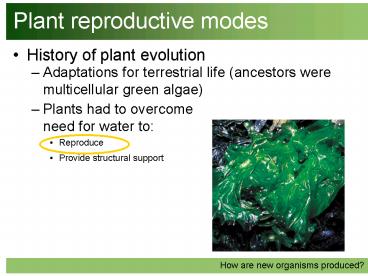History of plant evolution - PowerPoint PPT Presentation
1 / 9
Title:
History of plant evolution
Description:
Gametophyte (gamete-producing, haploid plant) egg. sperm. syngamy. zygote. embryo. mitosis. Gametangia (structure where gametes produced) mitosis ... – PowerPoint PPT presentation
Number of Views:88
Avg rating:3.0/5.0
Title: History of plant evolution
1
Plant reproductive modes
- History of plant evolution
- Adaptations for terrestrial life (ancestors were
multicellular green algae)
- Plants had to overcome need for water to
- Reproduce
- Provide structural support
How are new organisms produced?
2
Plant reproductive modes
- Simple plant taxonomy
- 12 living phyla (divisions) of plants
- 3 phyla are non-vascular (no specialized cells
for transport of water and carbohydrates such as
xylem or phloem)
- Phylum Bryophyta (mosses)
- 9 phyla are vascular (plants with vascular tissue)
- Seedless vascular plants
- Phylum Pterophyta (ferns)
- Seed plants
- Gymnosperms (Phylum Coniferophyta) plants with
ovules exposed at fertilization
- Angiosperms (Phylum Anthophyta) plants with
ovules enclosed within flower tissue at
fertilization
How are new organisms produced?
3
Plant reproductive modes
- Evolutionary pattern seen in reproductive modes
of plants
- Less reliance on water
- Increasing protection of embryo
- Reduced haploid stage of life cycle
- All plant life cycles are haplodiplontic ( both
haploid and diploid stages are multicellular)
- Animal life cycles are diplontic ( only diploid
stage is multicellular)
How are new organisms produced?
4
Plant reproductive modes
- Generalized life cycle of plants
egg
Haploid stage
Gametophyte
(gamete-producing, haploid plant)
sperm
Gametangia (structure where gametes
produced)
spores
Spore mother cell (diploid
cell that undergoes meiosis to produce haploid
spores)
zygote
embryo
Sporangia (structure where spores produced)
Sporophyte
(spore-producing, diploid plant)
Diploid stage
How are new organisms produced?
5
Plant reproductive modes
- Comparison of reproductive modes of plants
- Nonvascular plants (e.g. Phylum Bryophyta)
- Small, unspecialized plants (no true leaves or
roots)
- Sporophyte attached and (usually) nutritionally
dependent on dominant gametophyte
- Reproduction completely dependent on water
How are new organisms produced?
6
Plant reproductive modes
- Comparison of reproductive modes of plants
- Nonvascular plants (e.g. Phylum Bryophyta)
How are new organisms produced?
7
Plant reproductive modes
- Comparison of reproductive modes of plants
- Seedless vascular plants (e.g. Phylum Pterophyta)
- More specialized plants (true leaves and roots)
- Sporophyte dominant stage of life cycle
gametophyte reduced (unspecialized) and
independent
- Reproduction completely dependent on water
- Embryo slightly protected in archegonia
How are new organisms produced?
8
Plant reproductive modes
- Comparison of reproductive modes of plants
- Seedless vascular plants (e.g. Phylum Pterophyta)
How are new organisms produced?
9
Plant reproductive modes
- Comparison of reproductive modes of plants
- Other seedless vascular plants with similar life
cycles
How are new organisms produced?































